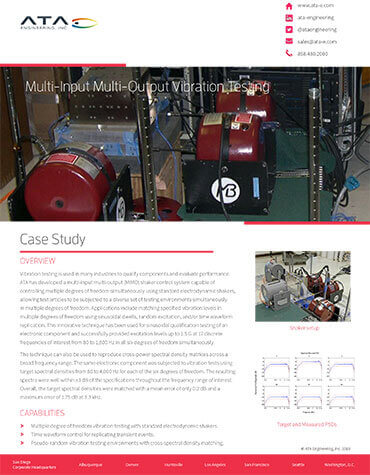Qualification testing demonstrates that when a structure is exposed to the type of service environment in which it is expected to operate, the overall system will meet all of its performance criteria. For aerospace products, the types of qualification tests needed typically include vibration and acoustic environments to evaluate the dynamic structural integrity of the system. Testing is often performed on electrodynamic shaker tables, in acoustic reverberant chambers, or using Direct Field Acoustic Testing (DFAT). Wind tunnel and aeroacoustic testing may also be performed.
Instrumentation is required during qualification testing to verify that the expected environment levels were actually applied to the structure, along with sensors to observe responses at critical locations to verify that the responses are as expected and confirm analysis predictions. Most qualification testing is much more than a simple pass-fail test.
ATA has considerable experience assisting with qualification test programs by providing the instrumentation and dynamic data collection systems needed to measure and analyze the results. Our analysis expertise is also instrumental in assessing results to provide a complete understanding of the qualification process.
Vibration qualification tests are conducted using shaker systems to apply random, sinusoidal, or combined environments to verify that a structure can survive what are often very harsh environments. The testing frequently requires measurements from a substantial number of sensors to verify appropriate structural behavior. ATA can provide the data collection tools needed to satisfy the amount and rates of data acquisition that are typically employed, and for efficiency, ATA is able to collect and process data quickly so that test coordination decisions can be made quickly. ATA captures all time-domain data required and can apply specialized signal processing to yield power spectral densities (PSDs), sound pressure levels (SPLs), and frequency response functions (FRFs) using IMAT™ to quantify dynamic system behavior.

Acoustic qualification testing involves the application of high-amplitude dynamic pressures over a broad frequency range. ATA can assist in the measurement of the microphone, accelerometer, vibrometer, and strain responses to quantify how well the structure accommodates this type of environment. ATA software allows SPL computation and various octave band analyses to be performed efficiently to confirm that qualification levels have been achieved.

It is often difficult to collect a large number of channels at high frequencies, but ATA has a variety of data acquisition systems that can be combined to accommodate a wide variety of test configurations and conditions. Our systems can be scaled and are transportable for remote test support.
Data Systems
- Brüel & Kjær LAN-XI
- VTI EMX Sentinel
- HBM SoMat
- Siemens SCADAS
ATA also has an in-house electrodynamic shaker table for conducting small test article qualification testing. Random, sine, and shock testing can be performed.

Wind tunnel testing often uses special dynamic fluctuating pressure sensors which yield very-high frequency content that needs to be collected at very high rates. It is critical that there be rapid evaluation of data quality since wind tunnel time is expensive and many test conditions are run in a very short amount of time. ATA can configure customized systems to support wind tunnel test programs using our various data systems. Rapid data processing allows test point evaluations to be performed quickly to minimize the total wind tunnel test time, resulting in reduced test costs.

Some qualification tests are unique in frequency content and amplitude and require special signal generation, control, and data collection. ATA has developed a specialized six-degree-of-freedom (6-DOF) vibration capability utilizing an array of small electrodynamic shakers. This application allows specialized input to electronic components to achieve qualification levels; specialized software measures and controls the test environment while all measurements are made. ATA can develop other specialized environmental test applications when needed.

Connect with us to discuss how our advanced multi-disciplinary team can help you achieve your engineering goals.




